
April 2012
Welcome to Net Results EXPRESS
Net Results EXPRESS (NRx) is an award-winning, monthly e-newsletter highlighting medical and scientific breakthroughs, major grants and honours awarded and other research-related events at UHN. Through NRx you can read about ongoing research at our five research institutes, the Ontario Cancer Institute (OCI), the Toronto General Research Institute (TGRI), the Toronto Western Research Institute (TWRI), the Toronto Rehabilitation Institute (TRI) and the Techna Institute for the Advancement of Technology for Health (Techna). We hope you will find this newsletter informative and helpful. If you have feedback or questions, please contact www@uhnresearch.ca. Christopher J. Paige, PhD, FCAHS |
Cancer: A New Understanding of Immune System Responses
In a mouse model, Dr. Cattral showed that DCs can lose their identity and generate new cells, similar in their properties to macrophages. Typically believed to help the body defend against illness, DC-derived macrophages were found to produce molecules that work against the body’s natural defenses. The team also found that a deficiency of a substance called granulocyte-macrophage colony stimulating factor that permitted the transition from DC to macrophage—a phenomenon only observed in mice with cancer. This previously unrecognized developmental pathway provides new insight into regulating DC levels and function during immune responses. Dr. Cattral adds, "This unexpected flexibility of DC development provides a basis for new approaches to manipulate immune responses in cancer, infectious disease and autoimmunity." Immunostimulatory conventional dendritic cells evolve into regulatory macrophage-like cells. Diao J, Mikhailova A, Tang M, Gu H, Zhao J, Cattral MS. Blood. 2012 April 6. [Pubmed abstract] This work was supported by the Heart and Stroke Foundation of Canada, the Canadian Cancer Society, the Canadian Institutes of Health Research, Astellas Inc. and the Toronto General Hospital Transplant Program. |
Breast Cancer: Gene Signatures for Better Treatments
The group examined tumour-initiating cells (TICs), cells that have the capacity to sustain the growth of a tumour, from mouse HER2+ mammary tumours. Gene expression patterns specific to these TICs were compared to those of clinical breast cancer samples. The researchers identified a 17-gene "signature" that predicts resistance to chemotherapy and clinical outcome of the high-risk human HER2+ estrogen receptor α– (ERα–) breast cancer. Specifically, this signature identified HER2+:ERα– breast cancer patients that would show better response to conventional chemotherapies in combination with trastuzumab, an anti-HER2 drug. "Previous to this discovery, there was no way to accurately predict which breast cancer patients would respond to chemotherapy alone and which would benefit from trastuzumab," says Dr. Zacksenhaus. "With this application, we can now identify and prioritize high-risk HER2+:ERα– patients for the most effective therapy." Dr. Zacksenhaus, Dr. Liu and their colleagues are now in the process of adapting this prognostic tool to the clinic by developing a NanoString-based assay on clinical samples obtained from Toronto hospitals. Seventeen-gene signature from enriched Her2/Neu mammary tumor-initiating cells predicts clinical outcome for human HER2+:ERα- breast cancer. Liu JC, Voisin V, Bader GD, Deng T, Pusztai L, Symmans WF, Esteva FJ, Egan SE, Zacksenhaus E. Proceedings of the National Academy of Sciences. 2012 April 10. [Pubmed abstract] This work was supported by the Ontario Institute for Cancer Research, the Canadian Breast Cancer Foundation, the Canadian Breast Cancer Research Alliance, the Breast Cancer Research Foundation and the Komen Foundation for the Cure. |
Spinal Cord Injury: Reducing Inflammation with a Smart Material
A new study from the laboratory of TWRI Senior Scientist Dr. Michael Fehlings, including his graduate student Jamie Austin, examined the use of a specific “hydrogel (HAMC)”—a type of smart material, in this case composed of special materials called hyaluronan and methyl cellulose, developed by McEwen Centre for Regenerative Medicine investigator Dr. Molly Shoichet—in an experimental model of PTS. When HAMC was injected into the layers surrounding the spinal cord in animals with the PTS injury, the extent of inflammation and scarring caused by this condition was significantly reduced. Moreover, further examination showed that HAMC injection led to improved functional and neurobehavioural recovery and reduced scarring in the injured region. "These findings are very interesting for the PTS community, who currently are without effective treatment options," says Dr. Fehlings. "HAMC, with further study and development, could represent a very possible treatment strategy that could have significant impact on SCI pathology and improve long-term recovery for patients with PTS." The effects of intrathecal injection of a hyaluronan-based hydrogel on inflammation, scarring and neurobehavioural outcomes in a rat model of severe spinal cord injury associated with arachnoiditis. Austin JW, Kang CE, Baumann MD, Didiodato L, Satkunendrarajah K, Wilson JR, Stanisz GJ, Shoichet MS, Fehlings MG. Biomaterials. 2012 March 27. [Pubmed abstract] This work was supported by the Physicians Services Incorporated, the Canadian Syringomelia Network, the McLaughlin Center for Molecular Medicine, the McEwen Centre for Regenerative Medicine and M. Fehlings’ Gerald and Tootsie Halbert Chair in Neural Repair and Regeneration. |
Diabetes: New Insight into Insulin Release
FAK has been shown to be recruited to focal adhesions—protein complexes that act as “sensors”—allowing messages from the external environment to communicate to the cell. In order to study the role of FAK in diabetes, mice lacking FAK in pancreatic beta cells were examined. Dr. Woo’s team found that these mice had smaller number of pancreatic beta cells, due to increased cell death. Importantly, without FAK these cells were unable to effectively transport insulin granules to the cell surface, leading to significantly reduced insulin secretion. Commenting on these findings, Dr. Woo explains, "These results highlight the importance of FAK in maintaining pancreatic beta cell mass and function." This newly identified function of FAK provides researchers with an important novel target for the development of therapeutics for diabetes. In vivo role of focal adhesion kinase in regulating pancreatic beta-cell mass and function through insulin signalling, actin dynamics, and granule trafficking. Cai EP, Casimir M, Schroer SA, Luk CT, Shi SY, Choi D, Dai XQ, Hajmrle C, Spigelman AF, Zhu D, Gaisano HY, Macdonald PE, Woo M. Diabetes. 2012 April 12. [Pubmed abstract] This work was supported by the Canadian Institutes of Health Research, the Canadian Diabetes Association and Alberta Innovates-Health Solutions. |
Prostate Cancer: Predicting Recurrence Using Oxygen Levels
Published in Clinical Cancer Research, the research team measured oxygen levels in tumours in 247 men with local prostate cancer prior to radiation therapy. In a follow-up with patients over a span of six years, researchers found that low oxygen levels in the tumours was associated with early relapse after radiation treatment. This discovery will enable doctors to better select the most appropriate and effective treatments for each patient’s individual tumour before the start of radiation therapy. Adds Dr. Milosevic, "At the heart of it, this is what personalized medicine is all about." Tumor hypoxia predicts biochemical failure following radiotherapy for clinically localized prostate cancer. Milosevic M, Warde P, Ménard C, Chung P, Toi A, Ishkanian A, McLean M, Pintilie M, Sykes J, Gospodarowicz M, Catton C, Hill RP, Bristow R. Clinical Cancer Research. 2012 April 1. [Pubmed abstract] This work was supported by the United States Army Prostate Cancer Research Program, the Terry Fox Program Project Grant through the National Cancer Institute of Canada, the Terry Fox Foundation New Frontiers Program Project Grant through the Canadian Cancer Society Research Institute and The Princess Margaret Hospital Foundation. |
Stroke Rehabilitation: Determining Fall Prevention Responses in Stroke Patients
Records from 47 patients, who completed 235 trials, were examined. In support of previous work, it was found that in 59% of trials compensatory stepping was initiated with the uninjured leg, in 37% were initiated with the injured leg and in 4% of trials there was no compensatory steps taken at all. When the ‘preferred’ leg was blocked, the appropriate, unblocked limb was used in 79% of trials and assistance to prevent a fall was required in only 9% of these trials. "These results demonstrate the importance of rehabilitation of balance control for stroke patients," explains Dr. McIlroy. "The development of strategies to encourage use of the appropriate leg to initiate compensatory stepping could help prevent falls linked to stroke." Determinants of limb preference for initiating compensatory stepping poststroke. Mansfield A, Inness EL, Lakhani B, McIlroy WE. Archives of Physical Medicine and Rehabilitation. 2012 April 4. [Pubmed abstract] This work was supported by the Heart and Stroke Foundation Centre for Stroke Recovery, the Heart and Stroke Foundation of Canada, the Canadian Institutes of Health Research, the Canadian Stroke Network and the Provincial Rehabilitation Research Program from the Ontario Ministry of Health and Long-Term Care. |
 |
![]()
 Congratulations to TGRI Scientist Dr. Jason Fish who has received an Early Researcher Award (ERA) from the Ontario Ministry of Economic Development and Innovation. The ERA program helps promising, recently appointed Ontario researchers build their research teams of undergraduates, graduate students, postdoctoral fellows, research assistants, associates and technicians.
Congratulations to TGRI Scientist Dr. Jason Fish who has received an Early Researcher Award (ERA) from the Ontario Ministry of Economic Development and Innovation. The ERA program helps promising, recently appointed Ontario researchers build their research teams of undergraduates, graduate students, postdoctoral fellows, research assistants, associates and technicians. Dr. Fish joined UHN in 2010 after a highly productive research fellowship at the Gladstone Institute of Cardiovascular Disease at the University of California, San Francisco.
The award will support Dr. Fish’s research into the molecular mechanisms that govern blood vessel pathology. Dr. Fish’s work aims to identify the pathways regulated by microRNAs during the inflammatory response, which contributes to the development of heart disease. His lab will seek to develop innovative therapeutic strategies that block blood vessel inflammation and pathogenesis by manipulating the expression of microRNAs.
 OCI Senior Scientist Dr. Rob Bristow has been named as a “national hero” by Prostate Cancer Canada (PCC). "In the field of prostate cancer, and especially as it applies to collaboration and leadership, Rob Bristow has no peer," said Steve Jones, President and CEO of PCC. "He is internationally respected for his achievements, and universally respected for his compassion, vision and strength of character.”
OCI Senior Scientist Dr. Rob Bristow has been named as a “national hero” by Prostate Cancer Canada (PCC). "In the field of prostate cancer, and especially as it applies to collaboration and leadership, Rob Bristow has no peer," said Steve Jones, President and CEO of PCC. "He is internationally respected for his achievements, and universally respected for his compassion, vision and strength of character.”In recognition of his standing in the prostate cancer research community, PCC—the only national foundation dedicated to prostate cancer awareness and research—awarded him the John Ferguson Memorial Award for Prostate Cancer.
 UHN welcomes Dr. Mathieu Lupien, OCI Scientist and Assistant Professor in the Department of Medical Biophysics at the University of Toronto. His research employs a functional "omics" approach to define the role of epigenetics and its interplay with genetic defects in cancer.
UHN welcomes Dr. Mathieu Lupien, OCI Scientist and Assistant Professor in the Department of Medical Biophysics at the University of Toronto. His research employs a functional "omics" approach to define the role of epigenetics and its interplay with genetic defects in cancer.Dr. Lupien joins UHN from the Norris Cotton Cancer Center and the Institute for Quantitative Biomedical Sciences at the Dartmouth Medical School, where he was an Assistant Professor in the Department of Genetics and Director of the Quantitative Epigenomics Laboratory. He received his PhD from McGill University and completed a postdoctoral research fellowship at the Dana-Farber Cancer Institute.
Feedback
Net Results EXPRESS is brought to you by UHN Research Communications. We hope you have enjoyed receiving this message. If you have any feedback, please email www@uhnresearch.ca.
To access archived issues of Net Results EXPRESS, visit uhnresearch.ca/news/netresultsexpress
Some images adapted from the image archives of stock.xchng.ca, Wikipedia and Dr. Mark Cattral.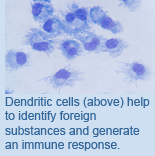 Specialized cells called dendritic cells (discovered by the late Nobel laureate and UHN advisor Dr. Ralph Steinman) play a key role in the immune system. These cells reside throughout the body and regulate responses to bacteria and viruses. Strong inflammatory stimuli can cause an abrupt decrease in the number of DCs, which tend to recover to pre-existing levels after the illness is resolved. In chronic inflammatory processes, such as cancer, DC fate is poorly understood. A team of researchers, led by TGRI Senior Scientist Dr.
Specialized cells called dendritic cells (discovered by the late Nobel laureate and UHN advisor Dr. Ralph Steinman) play a key role in the immune system. These cells reside throughout the body and regulate responses to bacteria and viruses. Strong inflammatory stimuli can cause an abrupt decrease in the number of DCs, which tend to recover to pre-existing levels after the illness is resolved. In chronic inflammatory processes, such as cancer, DC fate is poorly understood. A team of researchers, led by TGRI Senior Scientist Dr. 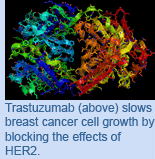 Breast cancer consists of a number of different subtypes, each with distinctive characteristics and responses to therapy, including human Epidermal Growth Factor Receptor 2-positive (HER2+) breast cancer. Despite new methods of treating HER2+ breast cancer, recurrence of drug resistant tumours is a concerning problem. TGRI Senior Scientist Dr.
Breast cancer consists of a number of different subtypes, each with distinctive characteristics and responses to therapy, including human Epidermal Growth Factor Receptor 2-positive (HER2+) breast cancer. Despite new methods of treating HER2+ breast cancer, recurrence of drug resistant tumours is a concerning problem. TGRI Senior Scientist Dr.  Traumatic spinal cord injury (SCI) is caused by a complex array of mechanical forces that damage the spinal cord. Some patients with SCI experience severe inflammation in the layers surrounding the spinal cord that can lead to the development of fluid-filled cavities. This condition, called post-traumatic syringomelia (PTS), is associated with chronic neuropathic pain, decreased motor function and sometimes paralysis.
Traumatic spinal cord injury (SCI) is caused by a complex array of mechanical forces that damage the spinal cord. Some patients with SCI experience severe inflammation in the layers surrounding the spinal cord that can lead to the development of fluid-filled cavities. This condition, called post-traumatic syringomelia (PTS), is associated with chronic neuropathic pain, decreased motor function and sometimes paralysis.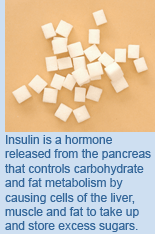 In healthy individuals blood sugar levels are tightly controlled. When blood sugar levels rise, insulin is released from pancreatic beta-cells. Stored within these cells as "granules", insulin is moved to the surface by the cell’s internal structural organization, known as the cytoskeleton. TGRI Scientist Dr. Minna Woo and colleagues have shown that a protein known as Focal Adhesion Kinase (FAK) is essential for proper movement of insulin granules through a complex process.
In healthy individuals blood sugar levels are tightly controlled. When blood sugar levels rise, insulin is released from pancreatic beta-cells. Stored within these cells as "granules", insulin is moved to the surface by the cell’s internal structural organization, known as the cytoskeleton. TGRI Scientist Dr. Minna Woo and colleagues have shown that a protein known as Focal Adhesion Kinase (FAK) is essential for proper movement of insulin granules through a complex process.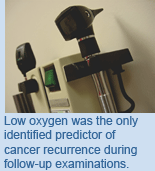 Prostate cancer is commonly treated with surgery or radiation therapy; however, cancer recurs or spreads in about 25% of treated men. A recent study led by OCI Clinician Scientist Dr.
Prostate cancer is commonly treated with surgery or radiation therapy; however, cancer recurs or spreads in about 25% of treated men. A recent study led by OCI Clinician Scientist Dr. 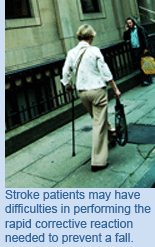 In order to prevent a fall, “compensatory steps” are taken to correct and regain balance. Previous studies demonstrated that young, healthy individuals will initiate compensatory steps with the leg bearing less weight, while stroke patients will tend to use their uninjured leg, which is also bearing the majority of the body weight, leaving these patients at an increased risk for falls. TRI Senior Scientist Dr.
In order to prevent a fall, “compensatory steps” are taken to correct and regain balance. Previous studies demonstrated that young, healthy individuals will initiate compensatory steps with the leg bearing less weight, while stroke patients will tend to use their uninjured leg, which is also bearing the majority of the body weight, leaving these patients at an increased risk for falls. TRI Senior Scientist Dr.